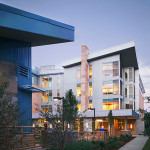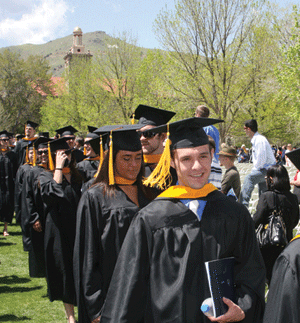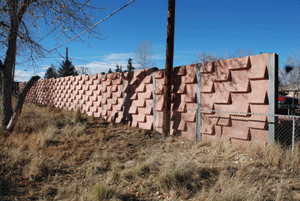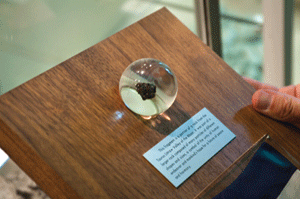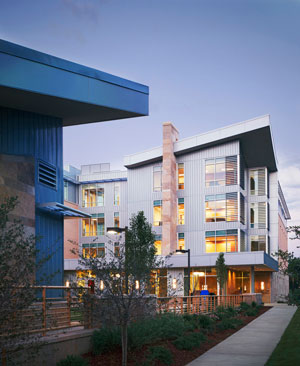
Situated close to the Student Recreation Center, the brand-new residence building, Maple Hall, opened its doors on August 19.
On August 19, 291 members of the Class of 2015 moved mini-refrigerators, laptops and laundry baskets into a brand-new residence facility located north of 17th Street on the east side of Maple. The first residence hall built on campus in more than three decades, Maple Hall comprises 98,000 square feet of living space and is LEED Silver-certified for its energy-efficient and sustainable design features.
Mines magazine recently toured the $27 million facility, beginning in the spacious lobby, where the school’s logo is deeply etched into a 6-foot-square slab of sandstone. With large windows facing north, comfortable seating, a gas fireplace and a grand piano, the area is bright and welcoming. We continued through several lounges and study areas, a game room, a multi-purpose meeting room, two outdoor courtyards and a community kitchen.
Our guide pointed out thoughtful details en route: Students have access to a sound-insulated room for music practice, and there’s space for bikes, skis and snowboards in a large storage space that doubles as a workroom for student projects.
Students we met along the way seemed pleased by their new home. Geology major Schaefer Buchanan, one of just a few sophomore students living in the residence hall this year, likes the way suites share a bathroom with the next-door room instead of an entire floor accessing communal washing facilities. He also remarked on the amount of community space and natural light, and the fact that they have access to group study areas and multimedia technology. “Last year we would have to go to the library or another building to study or rehearse a presentation, but that can all be done in the building now,” he said, adding that having a pool table right downstairs isn’t bad, either.
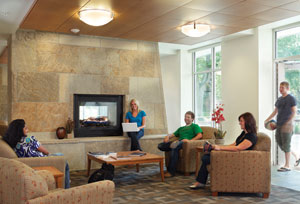
The residence hall occupies an area of campus that has been transformed over the past few years: The Student Recreation Center that opened in 2007 is just across the street, and the Brown Hall addition next door also opened this fall. A little farther off, at the corner of Elm and 18th streets, ground will soon be broken on the $2.8 million W. Lloyd Wright Wellness Center, a 9,000-square-foot facility that combines medical, dental and counseling services in a single modern facility.
Connecting these and other residential buildings to the heart of campus is a pedestrian plaza stretching south?on Maple Street from West Campus Road to 17th Street, and along one block of 16th, between Maple and Illinois. Eliminating vehicles from an area that now attracts more pedestrians than ever has had a big impact. “That part of campus feels more integrated now, it’s brought the surrounding buildings together,” says Will Weiskopf, a sophomore majoring in mechanical engineering. “It’s nice to move around and not have to think about cars.”
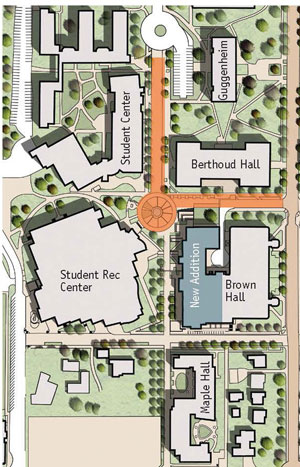
New campus construction includes Maple Hall, an addition to Brown Hall and two pedestrian walkways (identified in orange).
Multiple dividends
These investments bring Mines closer than ever to achieving the long-articulated goal of transforming the school into a truly residential campus. Starting this fall, all of Mines’ first-year students are required to live on campus, bringing the total number of students in residential housing to approximately 1,000. With renovations to Weaver Towers ongoing and additional residential facilities in the works, the school may be able to offer modern and centrally located housing to both the freshman and sophomore classes within a few years, while reserving accommodations in Mines Park west of campus for upperclassmen, graduate student and family housing.
Vice President for Student Life Dan Fox explains the reasoning: “Investments in our residential and recreational facilities are aimed at creating a more expansive educational experience.” Fox says that concentrating freshman and sophomore students close to the campus core is helping to create a more cohesive student community, which in turn creates numerous leadership opportunities. At the same time, the school can offer more recreational sports programs and a broader spectrum of extra and co-curricular activities, and proximity makes it easier for students to collaborate on group assignments.
Admissions is seeing dividends, too: These changes help the school compete for high-performing applicants. “We target students at the top end of the bell curve. It’s a small group, and they have options. Now that we can offer a more traditional residential campus experience with modern accommodations and recreational facilities, we are a more attractive option,” says Heather Boyd, director of enrollment management.
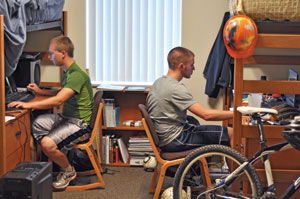
The modern accommodations are seen as a draw for top-performing students.
By several measures, this year’s incoming freshman class is the most academically prepared in decades. Their composite SAT score, which has increased 20 points each of the last three years, is the highest on record at 1290; their average ACT composite score is 29; and the average high school GPA is 3.8. Of the 970 incoming students, 40 percent are non-resident, the largest number ever admitted in a single class. It’s also a diverse group: Students hail from all corners of the nation and 16 foreign countries, women make up 25 percent of the class and 17 percent are ethnic minorities or multiracial.
Not surprisingly, the administration plans to forge ahead with a strategy that appears to be working, so in the future expect to see more efforts aimed at transforming not only Mines’ infrastructure, but also its academic and co-curricular programming, to foster a richer and more holistic student learning experience.
Hiring Frenzy
The caliber of today’s Colorado School of Mines students is reflected in continued high demand for graduates. Mines was again the top-ranked public university in the country for starting salaries of graduates with bachelor’s degrees, according to PayScale’s 2011-2012 College Salary Report. The report places median starting salaries at $63,400 and mid-career salaries at $106,000. Of last May’s graduating class, 81 percent reported placement within three months of graduating, and recruiting activity on campus continues to increase rapidly. Fall 2011 Career Day, which included 206 companies, sold out in only 10 weeks and more than 40 companies were on the waiting list for the event.

